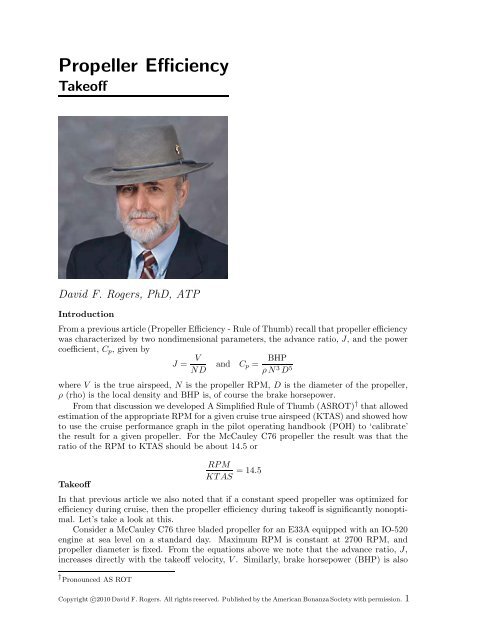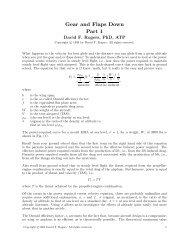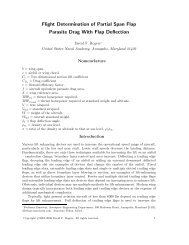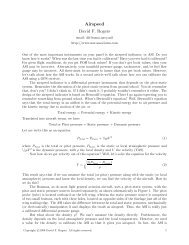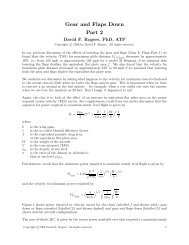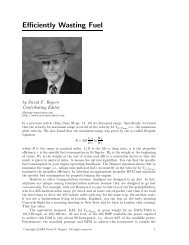Propeller Efficiency Takeoff - NAR Associates
Propeller Efficiency Takeoff - NAR Associates
Propeller Efficiency Takeoff - NAR Associates
You also want an ePaper? Increase the reach of your titles
YUMPU automatically turns print PDFs into web optimized ePapers that Google loves.
<strong>Propeller</strong> <strong>Efficiency</strong><br />
<strong>Takeoff</strong><br />
David F. Rogers, PhD, ATP<br />
Introduction<br />
From a previous article (<strong>Propeller</strong> <strong>Efficiency</strong> - Rule of Thumb) recall that propeller efficiency<br />
was characterized by two nondimensional parameters, the advance ratio, J, andthepower<br />
coefficient, Cp, givenby<br />
J = V<br />
ND and Cp = BHP<br />
ρN 3 D 5<br />
where V is the true airspeed, N is the propeller RPM, D is the diameter of the propeller,<br />
ρ (rho) is the local density and BHP is, of course the brake horsepower.<br />
From that discussion we developed A Simplified Rule of Thumb (ASROT) † that allowed<br />
estimation of the appropriate RPM for a given cruise true airspeed (KTAS) and showed how<br />
to use the cruise performance graph in the pilot operating handbook (POH) to ‘calibrate’<br />
the result for a given propeller. For the McCauley C76 propeller the result was that the<br />
ratio of the RPM to KTAS should be about 14.5 or<br />
<strong>Takeoff</strong><br />
RPM<br />
KTAS =14.5<br />
In that previous article we also noted that if a constant speed propeller was optimized for<br />
efficiency during cruise, then the propeller efficiency during takeoff is significantly nonoptimal.<br />
Let’s take a look at this.<br />
Consider a McCauley C76 three bladed propeller for an E33A equipped with an IO-520<br />
engine at sea level on a standard day. Maximum RPM is constant at 2700 RPM, and<br />
propeller diameter is fixed. From the equations above we note that the advance ratio, J,<br />
increases directly with the takeoff velocity, V . Similarly, brake horsepower (BHP) is also<br />
† Pronounced AS ROT<br />
Copyright c○2010 David F. Rogers. All rights reserved. Published by the American Bonanza Society with permission. 1
<strong>Propeller</strong> <strong>Efficiency</strong> – Take Off 2<br />
constant at 285 BHP. The density, ρ, is also constant. As a result, the power coefficient,<br />
Cp, is constant at<br />
Cp = BHP<br />
ρN3 =<br />
D5 (550)(285)<br />
(0.002378)(2700/60) 3 =0.0549<br />
(80/12) 5<br />
where the 550, 60 and 12 are conversion factors and 0.002378 is the density at sea level in<br />
appropriate units. Similarly, the advance ratio, J, is<br />
J = V<br />
ND =<br />
1.69V<br />
(2700/60)(80/12)<br />
1.69<br />
= V =0.00563V VinKTAS<br />
300<br />
The propeller efficiency from 10 to 110 KTAS is shown as the dashed red line on the<br />
bare propeller map in Figure 1. The black × indicates 70 KTAS, which is a typical rotation<br />
velocity for the E33A. The cruise results are also shown for comparison. From Figure 1 we<br />
see that the propeller efficiency during the takeoff run is significantly less than that during<br />
typical cruise conditions, represented by the colored dots. In fact, at 70 KTAS the propeller<br />
efficiency is approximately 0.65 (65%).<br />
Altitude effect<br />
An interesting question is: What is the effect of altitude on propeller efficiency during the<br />
takeoff run? It turns out that there is not much effect of altitude on the power coefficient.<br />
Specifically, the change in brake horsepower is approximately proportional to the change<br />
in density. Thus, the effect of altitude (density) on Cp a quite small. Using the altitude<br />
performance curves for the IO-520BB † the BHP at 10,000ft on a standard day is 200 BHP<br />
Power coefficient, Cp<br />
0.16<br />
0.12<br />
0.08<br />
0.04<br />
0<br />
Blade<br />
angle<br />
29.2 o<br />
25.2 o<br />
TNIO-520<br />
10,000 ft<br />
Take off<br />
20.2 o<br />
NAIO-520<br />
Sea level<br />
Take off<br />
15.2 o<br />
NAIO-520<br />
10,000 ft<br />
Take off<br />
10.2 o<br />
0.3<br />
0.4<br />
0.5<br />
<strong>Propeller</strong> efficiency, η<br />
0.6<br />
+<br />
+<br />
0.7<br />
0.8<br />
0.85<br />
.ο<br />
0.875<br />
0.9<br />
. ..<br />
.ο<br />
0.91<br />
Knee cruise value<br />
Altitude RPM BHP %<br />
6000 ft 2500 75<br />
7500 ft 2300 65<br />
8700 ft 2100 55<br />
14000 ft 2100 45<br />
11000 ft 2100 45<br />
0 0.5 1.0 1.5<br />
Advance ratio, J = V/ND<br />
Figure 1. McCauley C76 propeller map.<br />
†<br />
Teledyne Continental Motors, Aircraft Products Division, “IO-520 Series, Operator’s Manual”, Form No.<br />
X30041, September, 1980.<br />
Copyright c○2010 David F. Rogers. All rights reserved. Published by the American Bonanza Society with permission.
<strong>Propeller</strong> <strong>Efficiency</strong> – Take Off 3<br />
at 2700 RPM. Thus, the power coefficient Cp =0.052, which is very close to that at sea<br />
level. However, the advance ratio increases because the true airspeed at 10,000 ft is 81.5<br />
KTAS for an equivalent airspeed of 70 KTAS at sea level. These results are shown as the<br />
red long dashed line in Figure 1. The black + sign on the line corresponds to an equivalent<br />
airspeed of 70 KEAS (81.5 KTAS) at 10,000 ft. †<br />
The result is a small increase in propeller efficiency at the rotation speed of 70 KEAS<br />
(knots equivalent airspeed) compared to that at sea level, i.e., from approximately 0.65<br />
to 0.715. However, the takeoff ground run will still be longer because of the higher true<br />
airspeed at rotation at 10,000 ft.<br />
Turbonormalization<br />
Here, the advance ratio is the same as for the normally aspirated aircraft because the<br />
rotation velocity is the same. However, 10,000 ft is below the critical altitude for the turbonormalized<br />
engine. Hence, the full sea level power of 285 BHP is available. Because the<br />
density is lower, the power coefficient increases to Cp =0.0744 compared to the sea level<br />
value of 0.0549. The green solid line in Figure 1 shows the result. Again, a black + sign<br />
identifies the rotation speed of 70 KEAS. Compared to the normally aspirated IO-520BB,<br />
the TNIO-520BB suffers a decrease in propeller efficiency, i.e., from approximately 0.715 to<br />
0.69, at rotation.<br />
Another interesting question is: What is the effect on propeller efficiency during the<br />
takeoff run if we consider a turbonormalized TNIO-550B in an A-36 at 3600 lbs at 10,000 ft?<br />
At 3600 lbs the takeoff speed is 72 KEAS. At 10,000 ft 72 KEAS corresponds to a true<br />
airspeed of 83.8 KTAS. Thus, compared to a takeoff speed of 70 KEAS (81.5 KTAS) for<br />
the E33A the propeller advance ratio at takeoff for the A-36 increases as the ratio of the<br />
true airspeeds, i.e., by 83.8/81.5 =1.028 or by 2.8%. The power coefficient increases by<br />
the ratio of the BHPs, i.e., by 300/285 = 1.053, or by 5.3% The power coefficient is now<br />
Cp =0.0783 for the TNIO-550B. The detailed results are not explicitly shown in Figure 1.<br />
However, just looking at Figure 1 we can easily see that the efficiency for the TNIO-550B<br />
A-36 is not much different from that for the TNIO-520BB E33A.<br />
The next article will look at propeller efficiency during various cruise climb scenarios.<br />
† Here, for convenience, we assume that EAS = CAS = IAS. This is reasonable because compressibilty<br />
effects are small and for the Bonanza the pitot-static/position errors are also small.<br />
Copyright c○2010 David F. Rogers. All rights reserved. Published by the American Bonanza Society with permission.


